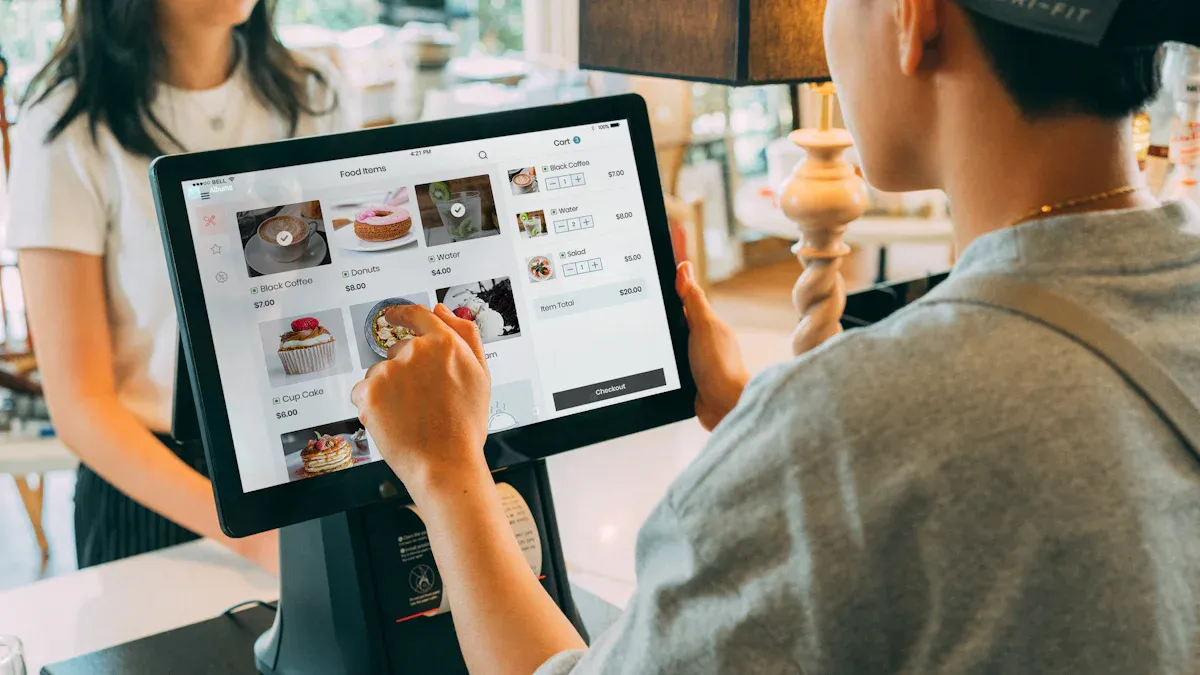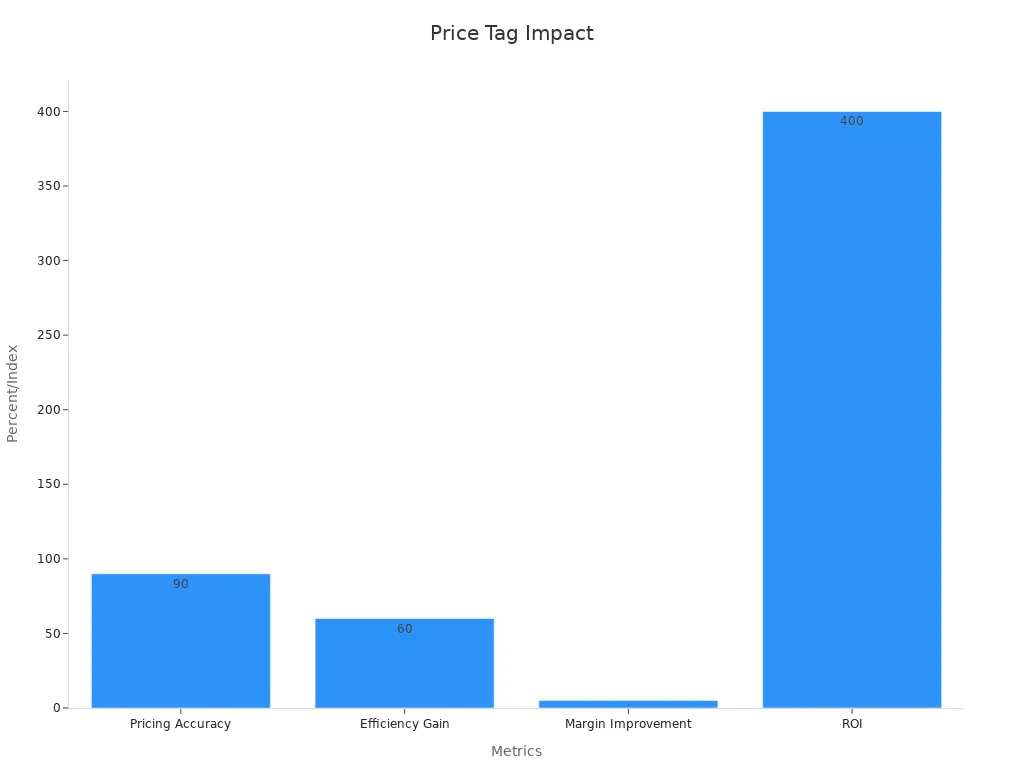
FamilyMart introduces Electronic Shelf Labels powered by the ESL Gateway AP, signaling a major step in Esl Retail innovation. Shoppers now notice ESL Price Tag displays that update instantly, transforming the in-store experience. This technology ensures accurate pricing and provides a seamless shopping experience. FamilyMart enhances accessibility and transparency, making every experience in their stores more efficient and reliable. Customers see these changes during each shopping trip, reflecting FamilyMart’s commitment to modern retail standards.
FamilyMart’s Digital Price Tags: What Shoppers Need to Know

How Digital Price Tags Change the Shopping Experience
Real-Time Price Updates at FamilyMart
FamilyMart’s introduction of digital price tags brings real-time price updates directly to the shelf. These electronic shelf labels allow staff to adjust prices instantly across all store locations. Shoppers see accurate prices every time they visit, which reduces confusion and eliminates outdated price tags. The digital displays ensure that promotions and discounts appear immediately, so consumers never miss out on real-time promotions. This system also supports dynamic pricing, which means FamilyMart can respond quickly to market trends, inventory levels, and competitor activity. As a result, grocery store price tags now reflect the most current grocery prices, creating a transparent and reliable shopping experience.
Japan leads the Asia Pacific region in electronic shelf label adoption, with FamilyMart standing out as an innovator. The company’s pilot program integrates digital price tags with loyalty app discounts, offering personalized pricing and enhancing customer retention. This approach sets FamilyMart apart from other supermarkets and digital grocery store competitors, who often struggle to update prices as efficiently.
Access to More Product Information with Digital Price Tags
Digital price tags at FamilyMart do more than display prices. These tags provide consumers with detailed product information, including ingredients, allergens, and nutritional facts. Shoppers can access this data directly from the digital displays, making it easier to make informed choices. The system also supports QR codes, which link to additional product details or special offers. This feature aligns with modern consumer expectations for transparency and convenience in a grocery store environment.
A recent survey of over 300 individuals found that enhanced product information through electronic shelf labels significantly improves both subjective and psychological well-being. Consumers feel more confident and satisfied when they have access to clear, accurate information. This improvement in the shopping experience encourages higher spending and positive word of mouth, which benefits both shoppers and retailers.
Immediate Benefits for Shoppers
Easier Price Comparisons in FamilyMart Stores
Digital price tags simplify price comparisons for consumers. Shoppers can quickly scan the shelves and see up-to-date prices for similar products. This transparency helps consumers make smarter purchasing decisions and increases trust in the store’s pricing. In digital grocery store settings, the ability to compare grocery prices in real-time gives FamilyMart an edge over traditional supermarkets, where manual updates often lead to inconsistencies.
The impact of these improvements is clear in FamilyMart’s operational metrics:
| Benefit Area | Improvement/Metric | Shopper Impact/Outcome |
|---|---|---|
| Wait Times | Pre-order and pick up in less than 2 min | Satisfaction and throughput improved by 30% |
| Error Reduction | Errors reduced by 50% | More accurate orders and smoother experience |
| Checkout Times | Checkout times reduced by up to 50% | Faster checkout, reducing cart abandonment |
| Basket Size | Basket size increased by 10%-15% | Higher purchase volume per shopper |
| Location-Based Promotions | 70% higher engagement rates | More relevant offers, increasing store visits |
These results show that digital price tags not only improve the accuracy of prices but also enhance the overall shopping experience by reducing wait times and increasing the value of each visit.
Improved Accessibility and Multilingual Price Tags
FamilyMart’s digital price tags improve accessibility for all shoppers. The digital displays use clear fonts and adjustable brightness, making prices easy to read for everyone, including seniors and those with visual impairments. The system also supports multilingual price tags, which cater to Tokyo’s diverse population and international visitors. Consumers can view prices and product information in their preferred language, reducing confusion and making the shopping experience more inclusive.
Tip: Shoppers can use their smartphones to scan QR codes on digital price tags for instant access to product details in multiple languages.
This focus on accessibility and inclusivity reflects FamilyMart’s commitment to serving a broad customer base. By leveraging digital technology, the company ensures that every consumer enjoys a seamless, informative, and efficient shopping experience.
Why FamilyMart Is Switching to Digital Price Tags
Goals Behind the Move
Boosting Efficiency with Digital Price Tags
FamilyMart aims to streamline store operations by adopting digital price tags. The company recognizes that price automation reduces manual tasks and increases accuracy. Automated pricing workflows allow staff to update prices across all locations in seconds. This shift eliminates the need for employees to walk the aisles and change tags by hand. The result is a significant boost in operational efficiency and a reduction in pricing errors.
The following table highlights the improvements seen with digital price tags:
| Metric | Evidence Supporting Reduction of Manual Error and Operational Efficiency |
|---|---|
| Pricing Accuracy | Over 90% accuracy in pricing predictions, reducing pricing errors and discrepancies |
| Efficiency Gain | More than 60% increase in operational efficiency through automated pricing workflows |
| Margin Improvement | Up to 5% margin improvement by minimizing pricing errors |
| ROI and Payback | 400% return on investment with a payback period of 9 months, showing cost-effectiveness |
| Labor Savings | Staff spend less time on manual price changes, allowing focus on customer service |
| Real-time Synchronization | Integration with POS and inventory systems ensures shelf and checkout prices always match, eliminating discrepancies |
| Automation Benefits | Faster price updates, reduced manual labor, and elimination of pricing mismatches improve workflows and accuracy |
Sam’s Club, for example, uses digital price tags to automate price updates. Employees now spend more time helping customers instead of changing tags. Wireless communication and cloud-based management keep shelf and checkout prices in sync. This approach leads to fewer errors, faster updates, and better customer satisfaction.

Responding to Retail Technology Trends
Retailers face rising labor costs and a need for greater efficiency. FamilyMart responds to these trends by investing in digital price tags. The market for electronic price tags is growing rapidly, with a projected CAGR of 20% over the next five years. Retailers seek to automate pricing to save on operational expenses and improve accuracy.
- Rising labor costs and shortages push retailers to automate pricing updates.
- Manual price changes can account for up to 5% of operational expenses in supermarkets.
- Electronic price tags reduce reliance on human labor, enabling long-term savings.
- Automation allows staff to focus on customer service and inventory management.
- Retail giants use digital pricing to respond quickly to promotions and ensure uniform prices.
- Cloud-based platforms enable real-time data integration, minimizing errors and maximizing promotional effectiveness.
Walmart’s dynamic pricing hub increased sales conversion rates by 23% in price-sensitive categories. CR Vanguard saved millions annually and achieved a payback period of three years. T11 reduced out-of-stock rates by 85% using analytics from electronic price tag data. These examples show how digital price tags help retailers stay competitive and meet customer expectations.
Issues with Traditional Price Tags
Manual Price Updates and Human Error
Traditional price tags require staff to update prices by hand. This process is slow and prone to mistakes. Employees may miss tags or enter incorrect prices, leading to discrepancies between shelf and checkout. Customers lose trust when prices do not match. Manual updates also delay the launch of promotions and price changes.
Labor and Cost Challenges
Manual price updates increase labor costs and reduce efficiency. Staff spend hours each week changing tags instead of helping customers. Operational expenses rise as stores print and replace thousands of tags. Price automation addresses these challenges by reducing the need for manual labor and lowering costs. Retailers can then reallocate resources to improve service and store management.
Benefits of Digital Price Tags for FamilyMart

Operational Improvements
Faster Price Changes Across FamilyMart Locations
FamilyMart’s adoption of digital technology enables rapid price changes across all store locations. The partnership with Panasonic introduced a system that connects shelf displays directly to the POS network. Staff no longer need to walk the aisles to replace price tags by hand. Instead, they can update prices instantly from a central dashboard. This automation eliminates manual errors and ensures that every shelf displays the correct price at all times. The automatic update capability leads to a significant reduction in the time required for price changes. As a result, FamilyMart can launch promotions or respond to market shifts without delay. Customers benefit from seeing accurate prices, which builds trust and enhances the shopping experience.
Enhanced Inventory and Stock Management
Digital shelf displays do more than show prices. They integrate with inventory management systems to provide real-time stock information. Store managers can monitor product levels and identify low-stock items quickly. This integration supports better price management by allowing dynamic adjustments based on inventory status. For example, if a product nears expiration, the system can automatically lower the price to encourage sales. Automation in inventory tracking reduces waste and improves overall efficiency. FamilyMart can optimize shelf space and ensure popular products remain available.
Cost Savings and Long-Term Value
Reducing Printing and Material Costs
Switching to digital shelf displays eliminates the need for printed price tags. Stores no longer spend money on paper, ink, or plastic holders. The reduction in printing and material costs contributes to long-term savings. Automation also reduces labor expenses, as employees spend less time on repetitive tasks. Over time, these savings add up and support the company’s sustainability goals.
Return on Investment for Digital Price Tags
Investing in digital transformation requires careful planning. Costs can range from tens of thousands to millions of dollars, depending on the scale of implementation. Hidden expenses such as data migration, system integration, and employee training must be considered. However, cloud adoption and automation help reduce operational costs and improve return on investment. Continuous monitoring and optimization ensure that systems operate efficiently. FamilyMart’s focus on scalable infrastructure allows the company to adapt as business needs grow. A thorough cost-benefit analysis helps ensure that digital investments translate into measurable value, such as improved efficiency, reduced overhead, and a better customer experience.
Note: Change management and employee upskilling are essential for maximizing the benefits of digital transformation.
Potential Drawbacks and Concerns with Digital Price Tags
Dynamic Pricing and Price Fluctuations
How Dynamic Pricing Works at FamilyMart
FamilyMart uses digital price tags to enable dynamic pricing strategies. The system updates prices instantly based on real-time data, such as product demand, inventory levels, and competitor pricing. For example, if a product nears expiration, the price can drop within seconds to encourage sales. The technology allows FamilyMart to adjust prices for seasonal items, slow-moving stock, or special promotions. Systems like Newton can update thousands of shelf labels in minutes, making dynamic pricing a practical tool for modern retail. This approach helps FamilyMart stay competitive and ensures that prices reflect current market conditions.
Impact on Shoppers’ Trust in Price Tags
Dynamic pricing introduces frequent price changes, which can create uncertainty for consumers. Shoppers may notice that prices fluctuate throughout the day or week, depending on demand and other factors. This volatility sometimes leads to concerns about transparency and fairness. Consumers want to trust that the price they see is the price they will pay at checkout. If prices change too often, some customers may feel confused or skeptical about the store’s pricing practices. Retailers must communicate clearly about how dynamic pricing works to maintain customer trust and satisfaction.
Privacy and Data Security Issues
Data Collection and Customer Privacy
Digital price tags often connect with store systems that collect data on customer behavior. These systems track which products attract attention and how shoppers move through the store. While this information helps FamilyMart optimize pricing and promotions, it raises questions about customer privacy. Consumers expect retailers to handle their data responsibly and protect their personal information from misuse.
Concerns About Tracking and Digital Price Tags
Some consumers worry that digital price tags could enable more detailed tracking of their shopping habits. The technology can record when and where customers interact with products, especially if linked to loyalty programs or mobile apps. Although this data helps improve the shopping experience, it also increases the risk of privacy breaches. FamilyMart must ensure robust data security measures to address these concerns and maintain consumer trust.
Impact on FamilyMart Employees
Job Changes and New Roles
The shift to digital price tags changes the roles of store employees. Staff spend less time on manual price updates and more time assisting customers or managing inventory. Some traditional tasks may disappear, while new responsibilities related to digital systems emerge. Employees must adapt to these changes and learn new skills to support the technology.
Training for Digital Price Tag Systems
FamilyMart invests in training programs to help employees use digital price tag systems effectively. Staff learn to operate central dashboards, troubleshoot technical issues, and explain dynamic pricing to customers. Proper training ensures smooth store operations and supports customer satisfaction. Ongoing education helps employees stay current with evolving retail technology.
Note: Clear communication and comprehensive training help employees and consumers adapt to digital price tag systems, reducing confusion and building trust.
FamilyMart and the Retail Industry: Digital Price Tags in Context
How Other Retailers Use Digital Price Tags
Supermarkets and Convenience Store Examples
Supermarkets around the world have embraced digital price tags to improve both efficiency and customer experience. Leading grocery retailers such as Walmart, Kroger, and Whole Foods use digital shelf labels to provide shoppers with detailed product information. Customers can scan these tags to access data about ingredients, sustainability, and dietary factors. This approach helps reduce confusion caused by inconsistent supermarket price tags and aligns grocery store price tags with online listings. As a result, shoppers experience greater satisfaction and trust in the displayed grocery prices.
Supermarkets also benefit from the data collected through digital price tags. These systems track consumer interactions, giving retailers valuable insights into shopper preferences. Retailers use this information to personalize marketing and develop targeted rewards programs. In addition, digital price tags help supermarkets standardize pricing and promotions across multiple locations, ensuring consistency for every customer.
Global Trends in Digital Price Tag Adoption
The adoption of digital price tags has accelerated since the early 1990s. Research indicates that the global market for electronic shelf labels will grow from $825.1 million in 2021 to $3.5 billion by 2031. Supermarkets and convenience stores worldwide use these systems to control pricing and promotions through cloud-based platforms. This technology allows retailers to provide timely, accurate, and sustainable product information to consumers. Studies show that digital price tags enhance consumer trust by ensuring price consistency across shelf, checkout, and online channels. Supermarkets that align digital grocery store price tags with product attributes reinforce confidence in the information presented.
Lessons from Early Adopters
Success Stories with Digital Price Tags
Early adopters of digital price tags report significant improvements in operational performance. The following metrics highlight the benefits:
- Labor cost reduction: Automated price updates save hundreds of labor hours each month.
- Improved price accuracy: Real-time alignment between shelf and POS reduces errors.
- Dynamic pricing revenue: Rapid price adjustments optimize margins and minimize markdown losses.
- Update response time: Pricing changes appear on shelves within minutes.
- Inventory turnover: Enhanced pricing strategies accelerate stock movement.
- Customer satisfaction: Clear and accurate pricing improves feedback.
- Reduction in pricing errors: Fewer product returns due to mismatched prices.
These results demonstrate measurable returns on investment and validate digital price tags as an effective tool for supermarkets and other retail sectors.
Challenges and Solutions
Despite the advantages, supermarkets face challenges when implementing digital price tags. Initial setup costs and system integration require careful planning. Staff must adapt to new workflows and receive training on digital systems. Retailers address these challenges by investing in scalable infrastructure and ongoing employee education. Cloud-based management platforms simplify updates and reduce technical barriers. By focusing on change management and continuous improvement, supermarkets ensure a smooth transition to digital price tags and maintain high standards of service.
What to Expect from FamilyMart’s Digital Price Tags Going Forward
Rollout Timeline and Store Coverage
Which FamilyMart Stores Will Get Digital Price Tags First
FamilyMart plans to introduce digital price tags in select flagship locations before expanding to additional stores. The initial rollout targets high-traffic urban stores in major cities such as Tokyo and Osaka. These locations serve as testing grounds for new technology and allow the company to gather feedback on system performance. FamilyMart prioritizes stores with diverse customer bases and high transaction volumes to maximize the impact of digital price tags. Early adopters will experience the benefits of real-time pricing, enhanced product information, and improved operational efficiency.
Expansion Plans for Digital Price Tags
After the initial phase, FamilyMart will expand digital price tags to more stores across Japan. The company uses data from pilot locations to refine its implementation strategy. Expansion focuses on regions with strong demand for convenience and technology-driven shopping experiences. FamilyMart aims to equip most of its stores with digital price tags within the next few years. This phased approach ensures a smooth transition and allows for continuous improvement based on customer and staff feedback.
Making the Most of Digital Price Tags as a Shopper
Tips for Navigating Price Changes
Shoppers can take advantage of digital price tags by staying alert to real-time promotions and product updates. Digital tags display accurate prices and highlight special offers instantly. Features such as color-coded lighting and product attribute icons help shoppers identify deals and make informed choices quickly.
- Digital price tags update automatically, reducing the risk of outdated or incorrect pricing.
- Color-coded lights on tags signal promotions, discounts, or special product attributes like organic or gluten-free.
- Shoppers can use the ‘Pick to Light‘ feature, which guides them directly to items on their shopping list, saving time and improving order accuracy.
- Product tags may display eligibility for government programs, such as WIC, making it easier to find qualifying items.
- Rich product information, including allergen details and sustainability scores, appears on digital displays, supporting better decision-making.
Retailers report that these features increase shopper confidence and convenience. Automation and AI-driven analytics ensure that price changes reflect current market conditions, helping shoppers find the best value.
Staying Informed About FamilyMart Price Updates
Staying informed about price changes helps shoppers maximize savings and avoid surprises at checkout. FamilyMart provides several ways for customers to keep up with digital price updates.
- Shoppers can scan QR codes on digital price tags to access detailed product information and current promotions.
- FamilyMart’s mobile app offers notifications about flash sales, new discounts, and personalized offers based on shopping habits.
- In-store signage and digital displays highlight ongoing deals and guide shoppers to featured products.
- Loyalty program members receive alerts about exclusive discounts and early access to special promotions.
Recent consumer studies show that shoppers increasingly rely on digital tools and notifications to track price changes and discover deals. As digital price tags become more common, shoppers who use these features can adapt their habits, find better prices, and enjoy a more transparent and efficient shopping experience.
FamilyMart’s digital price tags deliver measurable benefits for both shoppers and the company. The shift saves 12 hours of labor per week per store and increases annual profits by $4.5 million. Digital pricing also empowers customers with timely, personalized offers and clearer information, which increases satisfaction and trust.
| Metric | Traditional Retail | Digital Price Tags |
|---|---|---|
| Revenue Growth | N/A | 3.3x higher (3 years) |
| Inventory Turns | 4-6/year | 8-12/year |
| Customer Satisfaction | N/A | 40% higher |
Retailers adopting digital price tags see faster updates, fewer errors, and stronger customer relationships. This technology sets a new standard for convenience and transparency in everyday shopping.
FAQ
What are digital price tags at FamilyMart?
Digital price tags are electronic shelf labels that display product prices and information. Staff can update these tags remotely and instantly. Shoppers see accurate, real-time pricing and additional product details directly on the shelf.
How do digital price tags benefit shoppers?
Shoppers benefit from accurate prices, instant updates, and clear product information. Digital tags reduce confusion and make it easier to find promotions. Multilingual support and accessibility features help all customers navigate the store efficiently.
Can prices change during the day at FamilyMart?
Yes, prices can change in real time based on demand, inventory, or promotions. FamilyMart uses dynamic pricing to adjust prices quickly. Shoppers should check digital tags for the latest price before purchasing.
Are digital price tags secure and private?
FamilyMart uses secure systems to manage digital price tags. The technology does not collect personal shopper data from the shelf labels themselves. Data security and privacy remain a top priority for the company.
Will FamilyMart employees lose jobs because of digital price tags?
Employees will see changes in their roles. They spend less time on manual price updates and more time assisting customers or managing inventory. FamilyMart provides training for new technology-related tasks.
How can shoppers access more product information?
Shoppers can scan QR codes on digital price tags using their smartphones. These codes link to detailed product information, including ingredients, allergens, and special offers. This feature supports informed purchasing decisions.
Which FamilyMart stores have digital price tags now?
FamilyMart started with flagship stores in major cities like Tokyo and Osaka. The company plans to expand digital price tags to more locations over time. Shoppers can expect wider coverage in the coming years.
What should shoppers do if they notice a price discrepancy?
Shoppers should notify store staff immediately. Digital price tags synchronize with checkout systems, but technical issues can occur. Staff will resolve discrepancies and ensure customers pay the correct price.


